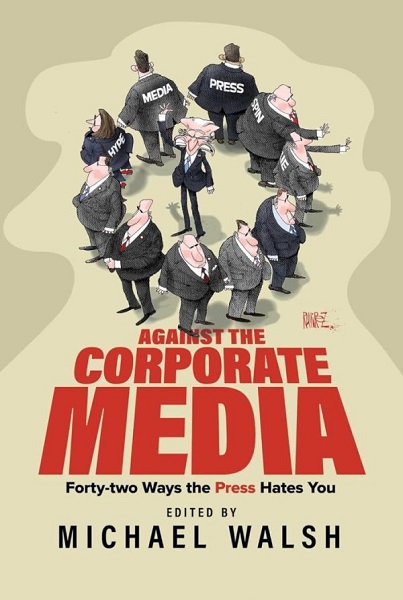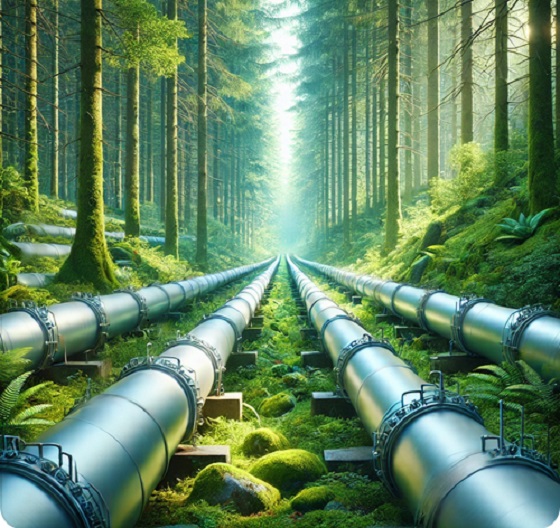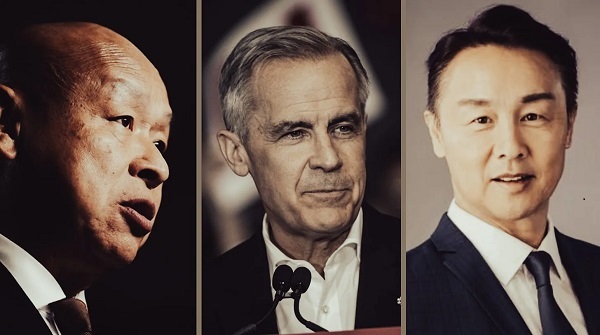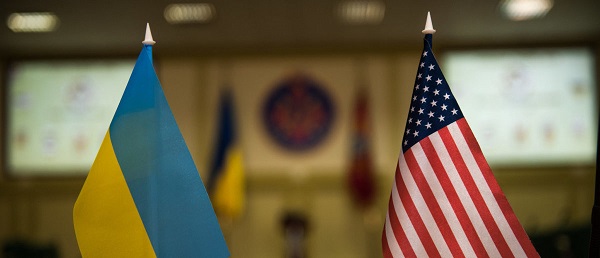Frontier Centre for Public Policy
“Forty-two Ways the Press Hates You” – The CBC Chapter

From the Frontier Centre for Public Policy
Excerpt from the book: Against the Corporate Media _ Forty-two Ways the Press Hates You (2024) – Michael Walsh ; chapter written by Elizabeth Nickson.
The Beast
Renegade governmental organizations are virtually impossible to rein in, especially if they have careened off the rails into destructive action. Take, for the sake of argument, the FBI or Environmental Protection Agency in the U.S., the World Health Organization and the United Nations internationally, or the plethora of sovereign and sub-sovereign health ministries that went AWOL during COVID-19. If threatened, a throng of defenders rises, vocal to the point of shrill, defending the original idea, refusing to look at the slavering beast that public money hath wrought.
“Reform or die,” says prime minister after president after premier. Nodding subservience is followed by…nothing.
Commissions are formed, recommendations are made. Cosmetic changes ensue. Like rogue elephants, they continue to roam the heights of the culture, braying and stomping and breaking things. Power, once acquired, needs to be wrenched from bleeding hands.
In Canada, that raging elephant is the Canadian Broadcasting Corporation. Founded in 1936, at last count, the CBC sprawls across the country in twenty seven over-the-air TV stations, eighty-eight radio stations, a flotilla of websites, podcasts, streaming TV, and multiple satellite radio stations. Its mandate is high-flown, to connect the multiple city-states of the country, its frozen north and isolated rural communities via dozens of offices big and small. It broadcasts in English, French, and eight indigenous languages.
The CBC’s Toronto headquarters, finished in 1993, was a statement of extreme optimism at a time when the corporation was widely loved. Designed by Philip Johnson, it cost $381 million. It is de-constructivist in form, a symbol of the CBC’s purpose, which is to re-conceive Canada’s founding as racist and the country in need of radical reform led by itself. Its orthogonal grid is “interrupted by skewed elements,” and its interior dominated by a green elevator shaft set at an angle to the building grid. Outside, a forbidding Soviet box, windows are outlined in CBC red. Inside, it’s confusing, echoing, and replete with empty studios. Despite effulgent funding, the aura of failure wears on those still employed. They don’t understand why they are no longer astride the culture.
A behemoth, it demands $1.24 billion of direct subsidy from the government every year and rakes in several hundred million more through licensing, advertising, and production subsidy. It eats up, say some analysts, half the media dollars spent in the country, yet is watched on its 27 TV stations by fewer than five percent of Canadians. Its news outlets perform worse. Only 1.75 percent of Canadian watch CBC news on broadcast channels or cable. The National, its star suppertime news show in Toronto, is watched by fewer than half a million people, while private-sector competitors in the same city crest at one million or even million.
In June 2023, the editorial board of Canada’s long-time national newspaper, The Globe and Mail, put its rather large bear paw down and suggested shuttering CBC TV entirely, and focusing on digital and radio, which are relatively successful. The editorial board (acting in its own institutional interest) pointed out that digital advertising for CBC should be halted because a subsidized CBC should not eat up ad dollars in a tight market. The editorial board also stated that more than 24 million CBC digital visitors a month is substantial. It is not. The media is undergoing explosive growth in every country; it is only legacy media that is not growing. Routinely in the U.S., popular digital sites host tens of millions of visitors a day and more than a billion a year. Using that metric, the CBC reaches about 10 percent of the available digital audience.
Most Canadians agree with The Globe and Mail. In fact, in mid-2023, 62 percent of Canadians wanted it shut down, saying they would vote for conservatives if they promised to do so.
Not reined in, not given less taxpayer money, not privatized, but shut down, its many buildings, its wealth of equipment sold, and its employees scattered to the winds. Among some 30 to 40 percent, the mother corporation (as it calls itself) is actively hated and loathed. When Pierre Poilievre, the popular conservative candidate leader, promised to shut down the CBC, his audience rose for a prolonged standing ovation.
How did this jewel of Canadian culture, which, for 60 years was held in near reverence by every sentient Canadian, come to this?
The Original Purpose
Public broadcasters, in general, engage in state-building and national and cultural integration. They “provide social cement,” build bridges, “witness,” and connect. Or are supposed to. They are meant to be free in order to serve those without the funds for cable or streaming subscriptions.
In Ireland, Raidió Teilifís Éireann (RTE) provides an alternative to the deluge of British programming, those in Nordic countries promote “equality, solidarity and belonging,” and in Australia, the Australian Broadcasting Corporation (ABC) sets itself against the dominance of wicked corporatist freebooter Rupert Murdoch.
In Canada, the CBC is meant to provide a Canadian voice in a country where, as the old saw goes, Canadian culture is in a distinct minority. This purpose has been served well in French Canada, where Radio Canada (best said with a French accent) is widely loved and has managed to act as a beacon for Quebecois culture, an impressive amount of it created to flout, humiliate, and laugh at the maudits anglais to the south, east, and west.
The digital and streaming explosion of the early aughts left the CBC flailing to catch up, and this is typically given as the reason its audience numbers are so poor.
However, this is not the case for the CBC’s radio stations, the only corporation division that truly services small-city and rural Canada and can compete in an admitted fever of ever-expanding competition. Their drive-time shows can reach as many as 20 percent of the audience and are often in first place in the ratings.
There are other rather more convincing arguments for its decline. CBC hosts on radio and TV have historically been beloved figures. Today, few Canadians could name one of them; personalities seemingly are not wanted at the CBC anymore, but Canadians still love them. Canadian YouTubers routinely attract hundreds of thousands of viewers and, in Jordan Peterson’s case, tens of millions, trouncing the “mother corporation” by orders of magnitude. Podcasts are popular, but half of those listened to in Canada are by right-wing Americans. This indicates that, even given its radio successes, the corporation has lost touch with Canadians. It simply does not have news or entertainment product strong enough to compete in the new marketplace. And, as the proliferation of new media in Canada proves, its editorial policy is so backward that almost every single digital opportunity has been missed.
In contrast to received opinion – which is that the culprit is the explosion in digital and streaming outlets – the answer to the corporation’s distress is far simpler and far more reparable. A series of bad political decisions have been made by policy chiefs who craft the corporation’s editorial policy every year. Reputedly, that secretive department costs taxpayers $180 million annually, but it is as closeted as the Kremlin, and few even admit it exists. But it does, and it is those policy setters who have created the wholesale repudiation of the CBC via rough-shod political brinksmanship that was meant entirely to remake Canada in a fresh, socialist image. And to destroy the one political party standing in the way.
Political Headwinds and Terrible Decisions The Canadian public’s loss of affection for the CBC began with their 27-year-long attack on Prime Minister Brian Mulroney, which started in the late 1980s with his election and ended only in 2011 with his exoneration by the Oliphant decision, a commission forced by the media after repeated failed attempts to destroy Mulroney. The goal, in retrospect, was not only to ruin Mulroney, who saw Canada as a potential capitalist titan using its vast natural resources, but to salt the earth so that no such animal could rise again. Like the later “Russian collusion” hoax employed against Donald Trump in the U.S., the Mulroney attacks were based on hate via creating a storm of noise and accusations, falsified evidence, and an egregious waste of taxpayer money. Like the Russia hoax, nothing was found. That was not the point. The point was to ruin Mulroney, deflect criticism, and silence conservative voices.
Mulroney, a brash-to-the-point-of-vulgar Irishman from Montreal, rode in on Ronald Reagan’s coattails with the North American Free Trade Agreement and the 1980s private-sector boom. Journalists in the Toronto-Ottawa-Montreal triangle hated him, and as an exhaustive study done at the time demonstrated, more than 90 percent of journalists in Canada were liberal or, more likely, socialist. In fact, as Barry Cooper and Lydia Miljan found in their 1993 book Hidden Agendas: How Journalists Influence the News, it was almost impossible to work in Canada’s media as a conservative unless you were tightly tied to the financial pages, and even then, if you had little to no profile as a columnist.
Immediately after Mulroney’s election, the CBC and the national newspaper, The Globe and Mail, went on the attack.
One investigative reporter, Stevie Cameron, who worked for both, grabbed the beat and did not let go.
What happened was a thorough illustration of a political hit job disguised as journalism.
Mulroney, possessed, it was thought, of an egregiously ambitious wife, was accused of taking a $300,000 cash bribe for awarding a 1988 Airbus contract. He had over his 10 years in office acquired a “friend,” Karlheinz Schreiber, a fixer/lobbyist who trolled capital cities for his clients. Schreiber, a native of Germany, was said to have promised Mulroney a job as a lobbyist when his ministership was over. Ultimately, this dubious choice in friends was the only charge that landed after 20 years of parallel investigations by the CBC and The Globe and Mail, a 10-year investigation by the Royal Canadian Mounted Police, several court cases, and finally a formal commission.
The CBC program The Fifth Estate produced nine documentaries trying to pin kickbacks on Mulroney, using as a principal source an accountant and friend of Schreiber who had spent time in Swiss, Italian, and American prisons. This man, Giorgio Pelossi, convinced the newsmen, that Mulroney had a secret Swiss bank account in which he had allegedly stashed millions, and petitioned the Swiss government to release the evidence. Neither the millions nor the Swiss bank account were ever found.
Finally, Mulroney had had enough and sued the CBC for libel. He won and then won again on appeal. These two court cases and decades-long investigations cost the CBC $15 million. Publishers and editors allowed reporters to use dubious sources in several books, which contributed to the downfall of one publisher, Key Porter Books. Schreiber, who was under deportation orders, told a Fifth Estate host on air that he would do anything not to be deported. The CBC ran with his “evidence” anyway.
Despite losing twice in court, the CBC continued its crusade: in 2010, 22o years after the Airbus contract was awarded, conservative Prime Minister Stephen Harper was forced to empanel a commission that cost the Canadian taxpayer another $14 million. Justice Oliphant found that “nothing inappropriate occurred during the meetings that Mr. Schreiber had with Mr. Mulroney.”
The CBC even commissioned Mulroney: The Opera, a $3 million and $800,000 film that was supposed to be shown in theatres first and on the CBC second. According to columnist Brian Lilley, the film portrayed Mulroney as an “American wanna-be with no ethics and an unquenchable thirst for power.” It was so terrible that not only did it not air on CBC, the CBC took its name off the disaster. Naturally, it was praised by The Globe and Mail.
During Steven Harper’s prime ministership, the CBC led an attack on four nominally conservative senators who had claimed expenses in hometowns that they rarely visited. This was unfortunate but a well-worn pattern. A few paid back those expenses – the largest bill was for $150,000 – and three were criminally charged and acquitted, but not before their lives had been shredded. The “scandal” over relatively small sums was meant to counter the rising suspicion of Canadians that the CBC and the government had run amok with spending and, in a masterful sleight of hand, proffered visible conservatives as punching bags. The “investigations” mirrored the attack on Mulroney and, as meant, affected the 2015 election, which was won by Justin Trudeau’s Liberal Party.
By then, Canadians, particularly those right of center, were sharply aware that Liberal scandals, far more egregious in terms of money misallocated, were ignored or glossed over.
By 2011, after the CBC again lost with the Oliphant Commission it had forced, the organization had lost 30 to 40 percent of the country along with it.
In 2010, Prime Minister Stephen Harper commissioned a report from the Senate Committee on Transport and Communications to devise ways to rescue the CBC. The recommendations included more ads, the cessation of in-house cultural programs, playing recordings, and selling off all its studios and buildings. In response, the CBC spent the next three election seasons – 2015, 2019, and 2021 – attacking conservatives with its every breath. In Justin Trudeau, the ideal leftwing pretty boy willing to be puppeted for power, the CBC had finally found a politician to love.
On the campaign trail, Trudeau and his team promised to increase the CBC’s funding. The CBC, in return, mirrored Trudeau’s campaign of conservative hatred, oil-sands hatred, and full-throated promotion of the “climate change” narrative. Harper, a stolid man married to reason, was subjected to daily character assassination, and his every move was portrayed as evil. When the CBC ran out of attacks on Harper, evangelical Christians, George W. Bush, most Americans, and “the extreme Right,” an almost psychotic hatred of Donald Trump and his “deplorables” poured from all 127 stations and their satellites all day, every day.
No opposing view was allowed, except those of nominal conservatives, tamed submissives brought on to bleat and cower.
Since Trudeau’s victories in 2015, 2019, and 2021, the CBC has enjoyed bumps in its annual budget by hundreds of millions of dollars despite its basement level ratings. And most conservatives who are not politicians are intimidated into silence. Many will not answer the phone if the CBC calls and dodge on-air invitations, effectively cancelling themselves. It is simply too dangerous to counter the force and fury of the CBC. In this, the policy chiefs won their battle and very nearly destroyed conservatism in Canada.
While also managing to destroy a beloved institution and, arguably, their own futures.
Why Don’t They Love Us Anymore?
It was the betrayal of the coronavirus pandemic that took the CBC from a rough 35 percent wanting reform to 62 percent wanting it shuttered in its entirety. During the spring of 2023, the citizen-funded National Citizens Inquiry travelled the country taking testimony from doctors, nurses, scientists, the vaccine injured, morticians, and public health officials. Two former employees of the CBC, both veteran journalists with sterling careers, reported what had happened. One, Marianne Klowak, anguished by the betrayal of her profession, told the story from the inside. The other, Rodney Palmer, who had reported from Beijing during the SARS epidemic, closely tracked the breakdown of the journalism profession via its accommodation made with governments and NGOs, compromised Canada Research Chairs (a government-funded chain of research fellowships), and the vaccine industry.
Who were we to withhold information that the public needed to know and had a right to know in order to make an informed decision? It tore me apart. We failed our audience; we let them down. It was a crushing burden. – Marianne Klowak
“We betrayed our audience, we betrayed their trust.”
Klowak, an award-winning 34-year veteran at CBC Manitoba, was used to having her stories turned around in a day, aired on TV, radio, and the web without question.
“We depended on our reputation for excellence over the years and used that reputation to effectively shut down one side of the truth. How were we doing that?”
We branded the doctors and experts we used as competent and trustworthy and those who challenged the government narrative, despite their reputations, as dangerous and spreading disinformation. It changed so fast it left me spinning. The rules changed overnight. It was a collapse of journalism. We changed from newsgathering to pushing propaganda.”
People called, emailed, and stopped her on the street, asking her what was going on and why wasn’t the CBC reflecting their concerns? A province-wide study showed that over 60 percent were worried about the vaccine’s safety, but any story she proposed about safety concerns was shut down. Every story about people who had lost jobs because of vaccine hesitancy, the vaccine injured, families broken, family members ostracized, depressed university students, suicides from lost businesses and incomes – that countered the government’s narrative was refused.
By early 2021, she found that the language in story meetings had also changed. Despite only four percent refusing the vaccine for religious reasons, anti vaxxers were labelled as religious nuts, uneducated, rural. “We were laughing at them, ridiculing them; it was pejorative…the opposite of journalistic practice.” Klowak’s breaking point came after Israel was starting to report evidence of inflamed heart muscles among vaccinated teenagers and people were calling her, worried about vaccinating their children. At the same time, the U.S. Centers for Disease Control and Prevention noted on its website that there had been rare cases of myocarditis among young people.
Her story about these side effects was sent to Toronto, where it languished for several months in the CBC’s own freshly created “public health unit” before it was returned with the instruction to use instead a group of experts chosen by CBC management, who claimed there was no risk from the vaccine. She refused, and the story was killed. In the meantime, many parents had been forced to vaccinate their children.
After another story was spiked, this one about a young woman runner with irreversible heart disease after vaccination, Klowak took early retirement, but not before requesting extensive exit interviews with local and national editorial types. Her concerns were dismissed. Brodie Fenlon, the corporation’s editor-in chief, stated that he thought the CBC had performed well.
The CBC is a public entity; we pay for it, it broadcasts on the public airwaves, and we expect them to tell us the truth because they’ve done it for 50 years. – Rodney Palmer
Rodney James Palmer had been a TV presenter, producer, reporter, and a 10-year veteran of the CBC, working in Israel and India as a bureau chief, and notably in Beijing during the SARS outbreak. Palmer had noticed a distinct difference in the Chinese response to Covid, especially by their quarantining Wuhan, and his suspicion was triggered, so he bent on studying the rollout of the pandemic.
He observed that a week into the pandemic, the CBC’s star reporter, Adrienne Arsenault, had run a story speculating how to respond if “your father” thought China had created the virus. She went on to lecture her audience on how to counter such “misinformation” and to use “trusted sources” from “legitimate organizations.” Palmer pointed out that at the beginning of any pandemic, all information is necessary for correct analysis. “What evidence did she have?”
He discovered that Arsenault’s source was an organization called First Draft, which emerged in March 2020 to counter “vaccine misinformation” and which recommended the use of only “trusted sources.” First Draft supported a pro-vaccine narrative, but Arsenault didn’t mention that.
Further, Palmer pointed out that in the same month, both The Washington Post and Vanity Fair had published deeply researched pieces raising suspicions about the Wuhan lab, but the CBC was already telling Canadians not to trust their own family members.
A few weeks later, Brodie Fenlon announced on his blog that the CBC had joined four organizations – First Draft, Project Origin, the Journalism Trust Initiative, and the Global Task Force – whose focus was to counter “misinformation.” One, the Trust Project, was joined by several dozen newspapers and broadcasters all over the world with the same mandate: to assert “trust” against “misinformation.” Their purpose:
“to develop a consensus and a single strong voice around the issues facing public media worldwide.” In public media, The Trust Project was joined by the BBC, ABC (Australia) France-TV, KBS (Korea), ZDF (Germany), and SVT (Sweden).
Palmer wondered what possible congruence the CBC would have with the Korean Broadcasting System (and why the word “truth” was no longer in use). He observed that developing “a single strong voice” was in direct opposition to actual journalism.
Palmer pointed out that the CBC’s Marketplace program had reported 800 social media posts that it judged to be “misinformation” to the Center for Digital Hate, and complained when only 12 percent were taken down. “Who at the CBC was the arbiter of the truth, when Canadians prefer to determine truth for themselves?” asked Palmer. How dare “the CBC promote a new identifiable group of Canadians and foment hate against them?”
Many journalists, some former, some having resigned during the pandemic, have gone on record to protest the corporation’s extreme bias. Others have left because the editorial policy has shifted from news gathering to promotion of the other-sexed and marginalized people of colour and disability, whereby every story has to include some element reflecting the persecution of the less-abled by white supremacists. While this is yet another reason for the CBC’s audience shifting away, it does not explain the active dislike and distrust exhibited by the public at present. The betrayal of trust, ironically, was everything. Klowak, before she retired, called around to journalists in the CBC and other newsrooms, asking if her experience was typical. It was, but many were, unlike her, in mid-career and afraid to lose their positions.
Then came the trucker protest.
During the trucker protest, Justin Trudeau’s behaviour mirrored his father’s punitive actions against violent French-Canadian separatists in 1970. The FLQ (the Quebec Liberation Front) had kidnapped two public officials and killed one of them. On the CBC and other media, Trudeau drew an equivalence between the FLQ and the trucker protest. He was able to do this because, on the second day of the massive protest in Ottawa, three photographs appeared of a Nazi flag, the American Tea Party flag, and the Confederate flag. These three photos were subsequently tracked down to timing, photographer, location, and lighting and are believed today to have come from the Prime Minister’s Office. Two photos were taken by photographers who had taken official portraits of Trudeau. A CBC journalist was the first to tweet the photos, refusing to reveal his source. Trudeau used these photographs as a pretext to refuse to meet with the protestors. The CBC aired the photographs repeatedly, skewing public opinion against the truckers.
During the protest, the CBC aired one blatantly critical piece after another. It never interviewed a protestor, despite the protestors being right outside the broadcaster’s Ottawa studios. Still, it was sure to include the entirely evidence-free accusation that Russia funded the protestors. This was to add insult to injury by further linking the protest to Trump and the equally fraudulent Russia hoax. It was as if the CBC, like spoiled children drunk on power, were wrecking Canada’s public square for fun, hurling crude epithets that suggested the Reign of Terror during the French Revolution or struggle sessions during the Chinese Cultural Revolution. It was chilling in its effect, and their behaviour disgusted a wide swath of the Canadian public.
According to reporters on the ground and subsequent investigations, it took the government two weeks to bring in the numbers of police deemed necessary to shutter the protest. The morning the shutdown happened, the protesters were faced with a phalanx of black-clad, Kevlar-coated men in battle order. None of the uniforms carried insignia. What looked like a winter carnival of people who had been cruelly separated and isolated for two years was swiftly shut down in a few brutal days, during which police rode a horse over an elderly woman, and organizers were jailed without charge for weeks. The CBC characterized protestors as rednecks and as American sympathizers, ignorant and anti-science, and claimed that money was coming in from American Republicans who wanted to take over Canada. The government confiscated $20 million in donations to the truckers from Go Fund Me and Give Send Go. The money was returned to the donors on the order of Trudeau’s deputy prime minister, Chrystia Freeland.
Freeland then froze the bank accounts of ordinary people, including waitresses and clerks, who had donated as little as $50 to the truckers. Even though the protestors were, by all accounts, 20 percent people of colour, all were dubbed racist. So much for knitting the country together.
The CBC has flagrantly betrayed the public trust, which is now reflected in its rampant unpopularity. Founded to “reflect Canada and its regions to national and regional audiences,” it has become a bully, a hysteric sowing division between every conceivable cohort, black against white, Indigenous against settler, the other-sexed against “normals,” and especially creating hatred against conservatives. By every imaginable metric the CBC has failed.
Moreover, it has almost destroyed the country’s fiscal integrity by becoming a shrill advocate for destructive public policies such as aggressive “climate change” mitigation in the coldest, most treed country in the world, thereby gutting the one industry – oil and gas – upon which one-third of the nation’s economy depends. Canadians now rank first among the G7 for debt-to-income ratio, and it is the public broadcaster’s prejudice and ignorance, above any other cultural institution, that is responsible.
Elizabeth Nickson is a Senior Fellow at the Frontier Centre for Public Policy. Follow her on Substack here.
Education
Our Kids Are Struggling To Read. Phonics Is The Easy Fix

From the Frontier Centre for Public Policy
One Manitoba school division is proving phonics works
If students don’t learn how to read in school, not much else that happens there is going to matter.
This might be a harsh way of putting it, but it’s the truth. Being unable to read makes it nearly impossible to function in society. Reading is foundational to everything, even mathematics.
That’s why Canadians across the country should be paying attention to what’s happening in Manitoba’s Evergreen School Division. Located in the Interlake region, including communities like Gimli, Arborg and Winnipeg Beach, Evergreen has completely overhauled its approach to reading instruction—and the early results are promising.
Instead of continuing with costly and ineffective methods like Reading Recovery and balanced literacy, Evergreen has adopted a structured literacy approach, putting phonics back at the centre of reading instruction.
Direct and explicit phonics instruction teaches students how to sound out the letters in words. Rather than guessing words from pictures or context, children are taught to decode the language itself. It’s simple, evidence-based, and long overdue.
In just one year, Evergreen schools saw measurable gains. A research firm evaluating the program found that five per cent more kindergarten to Grade 6 students were reading at grade level than the previous year. For a single year of change, that’s a significant improvement.
This should not be surprising. The science behind phonics instruction has been clear for decades. In the 1960s, Dr. Jeanne Chall, director of the Harvard Reading Laboratory, conducted extensive research into reading methods and concluded that systematic phonics instruction produces the strongest results.
Today, this evidence-based method is often referred to as the “science of reading” because the evidence overwhelmingly supports its effectiveness. While debates continue in many areas of education, this one is largely settled. Students need to be explicitly taught how to read using phonics—and the earlier, the better.
Yet Evergreen stands nearly alone. Manitoba’s Department of Education does not mandate phonics in its public schools. In fact, it largely avoids taking a stance on the issue at all. This silence is a disservice to students—and it’s a missed opportunity for genuine reform.
At the recent Manitoba School Boards Association convention, Evergreen trustees succeeded in passing an emergency motion calling on the association to lobby education faculties to ensure that new teachers are trained in systematic phonics instruction. It’s a critical first step—and one that should be replicated in every province.
It’s a travesty that the most effective reading method isn’t even taught in many teacher education programs. If new teachers aren’t trained in phonics, they’ll struggle to teach their students how to read—and the cycle of failure will continue.
Imagine what could happen if every province implemented structured literacy from the start of Grade 1. Students would become strong readers earlier, be better equipped for all other subjects, and experience greater success throughout school. Early literacy is a foundation for lifelong learning.
Evergreen School Division deserves credit for following the evidence and prioritizing real results over educational trends. But it shouldn’t be alone in this.
If provinces across Canada want to raise literacy rates and give every child a fair shot at academic success, they need to follow Evergreen’s lead—and they need to do it now.
All students deserve to learn how to read.
Michael Zwaagstra is a public high school teacher and a senior fellow at the Frontier Centre for Public Policy.
Economy
Support For National Pipelines And LNG Projects Gain Momentum, Even In Quebec

From the Frontier Centre for Public Policy
Public opinion on pipelines has shifted. Will Ottawa seize the moment for energy security or let politics stall progress?
The ongoing threats posed by U.S. tariffs on the Canadian economy have caused many Canadians to reconsider the need for national oil pipelines and other major resource projects.
The United States is Canada’s most significant trading partner, and the two countries have enjoyed over a century of peaceful commerce and good relations. However, the onset of tariffs and increasingly hostile rhetoric has made Canadians realize they should not be taking these good relations for granted.
Traditional opposition to energy development has given way to a renewed focus on energy security and domestic self-reliance. Over the last decade, Canadian energy producers have sought to build pipelines to move oil from landlocked Alberta to tidewater, aiming to reduce reliance on U.S. markets and expand exports internationally. Canada’s dependence on the U.S. for energy exports has long affected the prices it can obtain.
One province where this shift is becoming evident is Quebec. Historically, Quebec politicians and environmental interests have vehemently opposed oil and gas development. With an abundance of hydroelectric power, imported oil and gas, and little fossil fuel production, the province has had fewer economic incentives to support the industry.
However, recent polling suggests attitudes are changing. A SOM-La Presse poll from late February found that about 60 per cent of Quebec residents support reviving the Energy East pipeline project, while 61 per cent favour restarting the GNL Quebec natural gas pipeline project, a proposed LNG facility near Saguenay that would export liquefied natural gas to global markets. While support for these projects remains stronger in other parts of the country, this represents a substantial shift in Quebec.
Yet, despite this change, Quebec politicians at both the provincial and federal levels remain out of step with public opinion. The Montreal Economic Institute, a non-partisan think tank, has documented this disconnect for years. There are two key reasons for it: Quebec politicians tend to reflect the perspectives of a Montreal-based Laurentian elite rather than broader provincial sentiment, and entrenched interests such as Hydro-Québec benefit from limiting competition under the guise of environmental concerns.
Not only have Quebec politicians misrepresented public opinion, but they have also claimed to speak for the entire province on energy issues. Premier François Legault and Bloc Québécois Leader Yves-François Blanchet have argued that pipeline projects lack “social licence” from Quebecers.
However, the reality is that the federal government does not need any special license to build oil and gas infrastructure that crosses provincial borders. Under the Constitution, only the federal Parliament has jurisdiction over national pipeline and energy projects.
Despite this authority, no federal government has been willing to impose such a project on a province. Quebec’s history of resisting federal intervention makes this a politically delicate issue. There is also a broader electoral consideration: while it is possible to form a federal government without winning Quebec, its many seats make it a crucial battleground. In a bilingual country, a government that claims to speak for all Canadians benefits from having a presence in Quebec.
Ottawa could impose a national pipeline, but it doesn’t have to. New polling data from Quebec and across Canada suggest Canadians increasingly support projects that enhance energy security and reduce reliance on the United States. The federal government needs to stop speaking only to politicians—especially in Quebec—and take its case directly to the people.
With a federal election on the horizon, politicians of all parties should put national pipelines and natural gas projects on the ballot.
Joseph Quesnel is a senior research fellow with the Frontier Centre for Public Policy.
-

 2025 Federal Election1 day ago
2025 Federal Election1 day agoPoilievre To Create ‘Canada First’ National Energy Corridor
-

 2025 Federal Election1 day ago
2025 Federal Election1 day agoJoe Tay Says He Contacted RCMP for Protection, Demands Carney Fire MP Over “Bounty” Remark
-

 2025 Federal Election2 days ago
2025 Federal Election2 days agoChinese Election Interference – NDP reaction to bounty on Conservative candidate
-

 2025 Federal Election1 day ago
2025 Federal Election1 day agoHong Kong-Canadian Groups Demand PM Carney Drop Liberal Candidate Over “Bounty” Remark Supporting CCP Repression
-

 2025 Federal Election1 day ago
2025 Federal Election1 day agoLondon-Based Human Rights Group Urges RCMP to Investigate Liberal MP for Possible Counselling of Kidnapping
-

 Daily Caller19 hours ago
Daily Caller19 hours agoBiden Administration Was Secretly More Involved In Ukraine Than It Let On, Investigation Reveals
-

 2025 Federal Election1 day ago
2025 Federal Election1 day agoFixing Canada’s immigration system should be next government’s top priority
-

 2025 Federal Election22 hours ago
2025 Federal Election22 hours agoRCMP Confirms It Is ‘Looking Into’ Alleged Foreign Threat Following Liberal Candidate Paul Chiang Comments








